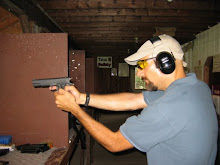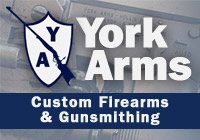1. ALL GUNS ARE ALWAYS LOADED.
I prefer to think of this one as "treat every gun as though it were loaded", because there are definite circumstances under which you know your gun is, in fact, not loaded. Every time a gun touches your hand, treat it as though it were loaded until you verify that it is not. I suspect this rule came into being because of the plethora of "I didn't know it was loaded!" excuses for NDs. Guns. Are. Dangerous. End of list. They're even more dangerous if you treat them like a prop or a toy without checking to see if they're loaded.
Rule 1 is deliciously simple; I think for that reason it tends to get overlooked. "Air is important for breathing", yeah, we tend to gloss over something that simple. An unloaded gun is a poor club; relatively harmless in the scheme of things, so the default more or less turns to "loaded" - which is good - except when it becomes so commonplace as to get forgotten. This dovetails with Uncle's Fifth rule - when that gun starts to fall, Rule #1 goes out the window and the dropper will instinctively grab for it. Unfortunately, the trigger guard is a handy little place to catch a firearm as it falls...
2. NEVER LET THE MUZZLE COVER ANYTHING YOU ARE NOT WILLING TO DESTROY.
Pretty self-explanatory. Don't point the gun at anything you are not willing to put a bullet into - or through. I'd argue that this is the single most important rule - if you never point the gun at something you aren't willing to shoot, you will never have a tragic accident. Even if you have a loaded gun, even if you put your finger on the trigger, as long as the gun is pointed in a safe direction (and "up" is not a safe direction), you'll be okay.
It's a pretty safe bet that we have all been muzzle-swept at one point or another; it's a pretty even bet that, if you spend enough time on the range, you might even sweep someone yourself. This rule gets tricky in that the only way to absolutely not cover someone with your firearm is to leave it in the safe - when you're carrying in a pocket, for example, your muzzle might point at the person across the table from you when you sit down to lunch. Now, granted, that's a holstered firearm that's not actively being touched, but it is still pointing in a direction you don't necessarily want to ventilate.
3. KEEP YOUR FINGER OFF THE TRIGGER UNTIL YOUR SIGHTS ARE ON THE TARGET.
Once again, pretty self-explanatory. The vast majority of modern guns will not fire without the trigger being pulled under any circumstance (barring mechanical failure, etc.) - the only way to make the gun go boom is to put your boogerhook on the bang switch. Keep said boogerhook off the trigger, no boom. It's just that simple. We most often see this rule broken in sensational photographs involving people and guns...
Here's another one that seems intuitively simple, yet gets broken all the time. We dry-fire, we test how a shotgun comes to shoulder, we check length-of-pull, etc. This is why having multiple rules is so important - if you're in a case where you must break a rule, obeying the other three prevents accidents from happening. If you're dry-firing, yet you have the gun pointed in a safe place, even if by some fluke the gun were to be loaded (obeying rule1!), you're still safe (although possibly deaf).
4. BE SURE OF YOUR TARGET.
Most often "and what's beyond it" is appended to this one; a bit superfluous of course but not a bad idea. Hand in hand with #2, tragedies can be averted by following these two. It's a sad rite of passage, every year around this time we hear of some poor innocent out for a walk in the woods who catches a round from a hunter who breaks this rule. Alternately someone will get hit by a falling round - "gun clapping" - or one that leaves the range. This rule is often paired with "you own every bullet you fire".
This rule should be extrapolated to include backstops and such whenever shooting. Things like rocks, bodies of water, or misshapen steel targets should be taken into consideration - things like what happens if your round catches a rock hidden in the dirt berm? Backstops should be solid but not too tightly packed; steel spinners, poppers, or plates should be placed in front of solid backstops and should be free of holes or dents that could unexpectedly alter a bullet's path. Even something as simple as using the right firearm - like not shooting a high-powered rifle at a steel pistol target - falls under this rule.
This isn't meant to disparage any of the other suggestions; Tam's is downright elegant in its simplicity - I'd boil it down even simpler to "Guns are not toys". It seems like the vast bulk of "accidents" result from people failing to treat a particular firearm with the proper respect and pointing it at something they shouldn't and putting their finger on the trigger. In order for something bad to happen - for someone to get shot "accidentally" - all four rules have to be broken
- The gun has to be treated as though it were empty - if you really thought the gun you pointed at your friend was loaded, then you were attempting murder.
- The muzzle was not pointed in a proper direction - if you wanted a hole in your friend, see the previous statement.
- A finger touched the trigger before the target was acquired - obviously, if you'd see that your friend had a loaded gun pointed at him, you wouldn't pull the trigger.
- The backstop was not safe - unless you happen to be in the habit of using friends as berms.
That is all.







7 comments:
I've advocated for Guns are not toys, don't play with them! as the primary rule for a long time now. It's my own Adamantine Rule, as I refer to it.
"Tam thinks it can be distilled to one."
I sure as hell do not.
Oops! Sorry about that - will amend shortly. Never said reading for comprehension was my strong suit...
Thank you. :)
(WV: "Nombacet" A prescription tranquilizer for marsupials.)
I left this comment over at Alan's:
A cop in a Charlotte airport said he boiled the rules down to two (excuse my language):
1. WATCH THE FUCKING MUZZLE.
2. WATCH THE FUCKING TRIGGER.
(This is the same guy who told me that the motto “Serve and protect” should more accurately be changed to, “We can’t get there in time to protect you, but we’ll try to clean up the pieces afterward.” Yes, he was a big fan of educated gun-toting citizens.
I always add "The Golden Rule of Tool Use":
"If you don't know what you are doing, Don't."
This covers all sorts of Gun Safety situations: Improper ammunition (Sellier & Belliot bulk 8x57 in a Commission Rifle?), reloading practices (What do you mean I need to trim them? They have worked just fine 6 times already...... is this H110 or H414? Looks like the 414 ....)
It covers all tools (Why can't I just put the board on the other side of the table saw and pull it through?).... because just as a tool makes work easier, it also also makes it easier to injure youself.... add a chemical reaction or an electric motor in there and the time required for work done/damage done decreases exponentially.
I've pondered the rules some, and think that 2 and 4 could stand to be combined.
If you think about it, everything the muzzle covers is a target. You might have that muzzle on something you are willing to destroy, like, say, the ground or a bullet trap, but that you aren't actually intending on shooting, and that, mentally, might not register as a target - but rule 4 is still needed, since it IS a target.
Perhaps...Never let the muzzle cover anything unless you are willing to destroy it and what is BEYOND it.
I like Tam's "Don't be an idiot" rule, but that really should be Rule 0 for life, not just for guns.
Alan does have a point, if you follow his two rules, it doesn't matter if the gun is loaded or not. I think, however, that Rule 1 needs to stand, as is, because it is an additional reinforcement to the idea.
Post a Comment